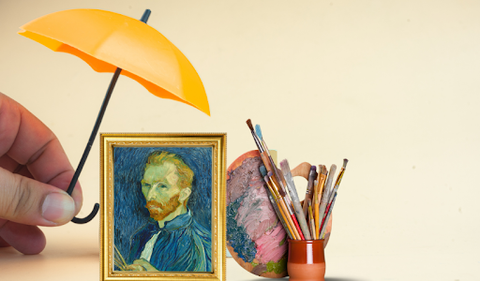Do you own valuable art but aren't sure how to protect it? You may have heard about art insurance but are uncertain about the next steps. No need to worry—we understand that investing in art has become increasingly lucrative in today's challenging world. Whether you're an art gallery owner or an exhibitor, your collection is invaluable. Therefore, we have covered the complete process of art insurance, including the nature of covered damages and exclusions.
Artwork insurance is a type of insurance designed to protect valuable artwork and paintings. The insurance protects against potential damage, loss, theft, or destruction. The insurance policy provides art collection financial compensation to the owner in case of covered perils.
So without delay, let’s discuss how to protect your art.

Importance Of Artwork Insurance
To understand why art insurance is important, considering what happens if you don’t opt for insurance is equally necessary. Whether you have collected art for an investment purpose or it holds sentimental or emotional value, your assets' potential damage or loss could pose a significant financial threat to your overall net worth. Insurance provides financial protection against loss, damage, or theft. Without insurance, replacing or repairing valuable artwork could be expensive.
What is included in Fine Art Insurance?
Fine art insurance includes the following art pieces:
- Paintings
- Sculptures
- Drawings
- Prints
- Rugs and tapestries
- Collectibles
- Antiques
- Decorative objects
- Photographs etc.

Understanding The Art Insurance Process
Artwork is often expensive. They must be insured, like other household items such as a car and a house. If you have decided to get your artwork insured, follow these steps to get the process started.
Assessing The Value Of Artwork
There are two options: either you bought or inherited the artwork. If you have bought it yourself, you must know the value of art. But if it is inherited or gifted, you should evaluate the artwork for its current market value. You can visit an art appraiser or contact the auction company for a value estimation. Click here for a complete guide on how to value your artwork.
Research An Insurance Agent
Search for the insurance companies that provide specialized insurance for your artwork. Some homeowner's and renters' insurance policies offer coverage for artwork. But this coverage is for a limited amount and type of loss. Therefore, first, identify reputable art insurance companies in your area and schedule one-on-one meetings to understand their policies.
Request Quote
Research the company's credibility and then ask for a quote. Today, almost all companies are online and can email you the quotation with the information you provided. Collect quotations from a few companies, shortlist them, and then schedule your interview with an agent. Provide them with detailed information about your collection. Include the total value and your specific requirements in your query.

Compare And Finalize The Policy
After receiving the quote, compare them regarding coverage options, limits, deductions and exclusions, and any benefits the company offers. Also, keep the institute's reputation and the quality of its customer service in mind because, ultimately, they matter. Once reviewed, select the policy that fits your requirements and budget.
Insurance Coverage
Take your time with your insurance option, and spare a good amount of time to study their terms and conditions carefully to avoid future conflicts. You can learn more about what is and is not covered by insurance by reading the policy. Pay close attention to exclusions, deductibles, coverage limits, and any requirements for maintaining the artwork's condition.
Submit An Application
With the help of an agent, fulfill all the documentation requirements. This includes filling out forms, appraisals, art descriptions, documents, purchase receipts, certificates of authenticity, provenance records, photographs, etc.
Undergo Underwriting
The insurance company will take some time to review your application and documentation. They will assess the risk associated with your artwork. They can further evaluate your collection’s value, condition, and the security measures you have implemented. After your application is routed through different departments and approved, the agent will inform you about the final decision. You must be patient, as the insurance applications take some time to approve.
Receive Policy Documents
Once your application is approved, you will receive the policy documents. This will include your insurance details, coverage, and terms and conditions. Carefully review the insurance documents before signing. Check if the documents reflect the coverage you agreed upon.
Pay Premium
After signing the agreement, you must pay for the premium. Keep records of your premium payments for future reference.

Regular Appraisals
Check the market value of your art from time to time, preferably annually. In certain cases, the market value changes significantly, so keep yourself updated on the worth of art. This will help you determine whether the insurance coverage remains adequate.
Check Your Art Documentation
For art insurance, maintaining the documentation is mandatory. Documents include artworks, photographs, appraisals, purchase agreements or receipts, provenance, insurance policies, premium receipts, and other related documents. These documents will be helpful in the event of a claim. Document each piece of art in your collection. This includes description, dimensions, artist (if known), acquisition date, purchase price, and current estimated value.
Schedule Artwork For Full Coverage
Homeowners', condos, or renters' insurance policies generally cover personal property. This insurance includes coverage for artwork up to a certain limit. However, these policies have the option of sub-limits for high-value items like artwork. This coverage may also not fully cover the replacement cost. So, scheduling individual artwork or adding a rider can provide additional coverage to protect the artwork's full value.
When insuring multiple artworks or high-value items, scheduling each piece individually or as a collection is common. This ensures that each item is specifically covered, and their value is accounted for in the insurance policy. Therefore, an insurance rider, an endorsement, or floater can add coverage to an existing insurance policy for specific items besides the base policy.
Cost of Fine Art Insurance
There is no fixed fee for artwork insurance, but it is not costly either. For example, for $20,000 worth of painting, the premium cost could be $200 to $400. The cost is usually charged annually. This small cost can secure your exquisite art's value against unexpected loss and damage. For an exact estimation, only an insurance company can provide you with a quote.
Type Of Damage Coverage
The following are the common losses and damages that artwork insurance may include. However, this may vary from company to company, which you should be aware of during policy acquisition.
- Loss or Damage: This includes accidental damage such as fire, theft, vandalism, water damage, natural disasters, and transit-related incidents.
- Theft And Burglary: This includes protection against theft or burglary of artwork, whether from your home, gallery, storage facility, or while in transit.
- Breakage: It covers damage to artwork due to mishandling and falling.
- Disappearance: If your artwork goes mysteriously missing, some policies offer coverage for that circumstance. But here, certain conditions need to be met.
- Worldwide Coverage: Many policies provide coverage for artwork regardless of its location, whether it's in your home, a gallery, a storage facility, or on loan to a museum or exhibition.
- New Acquisition: You have acquired and added a new artwork to your collection during the policy period. If you have also informed the insurer within a limited time frame (usually 90 days) and got the records updated, then this art is also included in the coverage.
- Appraisal Costs: Reimbursement for obtaining appraisals or valuations for your artwork, especially if required for insurance purposes, is also included.
- Restoration Cost: It includes the cost of conservation or restoration services for repairs and damages to the artwork.
Exclusion
- Wear And Tear: General wear and tear are not covered. It includes deterioration with time, such as fading, discoloration, item aging, etc.
- Poor Maintenance: Improper handling, improper storage, or failure to maintain the artwork in good condition according to industry standards is also not included.
- War And Nuclear Hazard: Damage or loss caused by war, terrorism, civil unrest, acts of aggression, military action, political instability, nuclear reactions, radiation, radioactive contamination, or nuclear war are excluded.
- Illegal Activity: Damage from illegal sales, smuggling, or trafficking is not included in the insurance coverage.
- Lack Of Security Measures: When the art lacks proper security measures, such as unattended public exposure to the artwork, unauthorized exhibitions, unlocked spaces, improper atmosphere management, or not storing art in unapproved boxes.
- Act of God: This includes damage due to natural disasters such as earthquakes, floods, hurricanes, tornadoes, or other catastrophic events unless included in the policy.
How Artwork Insurance Works
Policy Obtained
Once you have received an insurance policy, you must generally pay the premium annually. However, the tenure can vary based on availability and your selection. The insurance tenure also varies depending on insurer policies and your chosen choice. Usually, it is for one year and is renewed every year.
Damage And Claim Process
In case of any mishap, the owner informs the insurance company on priority to initiate the claim process. The owner then submits a claim to the insurance company along with the documents, including appraisals, purchase receipts, photographs, and other relevant information.

Adjuster Evaluation
Upon receiving the claim, the insurance company assigns an adjuster to evaluate it. The adjuster then assesses the extent of the loss. This investigation can require more documentation or information as needed.
Claim Settlement
Once the claim is approved, the insurance company reimburses the owner for the covered damages. The insurance company minutely considers the policy's coverage limits, including any deduction as per policy. Usually, the value of the artwork described in the policy determines the final settlement amount.
Final Verdict
Art insurance is important for collectors, owners, and exhibitors. It provides your assessed protection from loss and damages. The process includes carefully approaching reputable fine art insurance companies and comparing them to find the better option customized to your requirements. Furthermore, document every art description, including certificate of authenticity, receipts, etc. Apply for the insurance; the premium payment must be made annually once approved. In case of damage, the amount can be claimed as per the terms and conditions of the policy you agreed upon.

